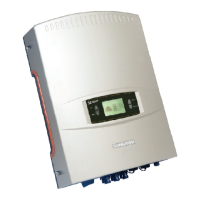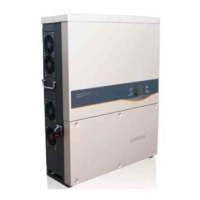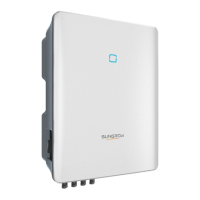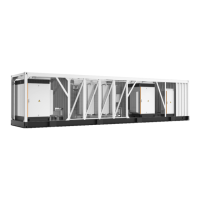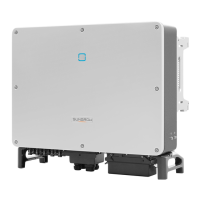Do you have a question about the Sungrow SG4KTL-M and is the answer not in the manual?
Explains the manual's aim, related documents, and target audience.
Guidance on reading and utilizing the manual effectively.
Explains hazard symbols indicating high/medium risk and potential injury.
Explains symbols for low risk injury and property damage.
Explains symbols found directly on the inverter body for safety.
Crucial safety information for installation, operation, and maintenance.
Describes the inverter's purpose and application in small PV power systems.
Details the physical aspects and components of the inverter.
Explains the internal workings and capabilities of the inverter.
Checklist of items to confirm before starting the inverter.
Step-by-step guide to start up and test the inverter.
Procedures for safely switching off and disconnecting the inverter.
Steps for removing and responsibly disposing of the inverter.
How to diagnose and resolve issues with LED indicators and LCD screen faults.
Procedures for keeping the inverter in good working condition.
Explains the functions of the inverter's two control buttons.
Diagram showing the structure and navigation of the inverter's LCD menu.
Comprehensive technical specifications and data for the inverter.
Legal disclaimer regarding warranty and product use.
Information about the manufacturer, Sungrow.
Crucial safety information for installation, operation, and maintenance.
Safety requirements for installing the inverter.
Warnings related to handling, ventilation, and electrical connections during installation.
Warnings about lethal voltage during electrical connection.
Safety precautions during operation, maintenance, and servicing.
Risks and precautions for incorrect service work and ESD.
Keeping non-related persons away and ESD precautions during work.
Importance of labels, country settings, and regulatory compliance.
Describes the inverter's purpose and application in small PV power systems.
Inverter cannot connect to PV modules requiring positive/negative terminal grounding.
Details the physical aspects and components of the inverter.
Prohibits usage other than intended and specifies input/connection rules.
Provides physical dimensions and weight specifications for the inverter.
Explains the human-computer interaction interface of the inverter.
Explains the meaning of the RUN and FAULT LED indicators.
Explains the internal workings and capabilities of the inverter.
Details the main circuit diagram and its components.
Outlines the primary functions such as conversion and data storage.
Describes the RS485 interface for monitoring devices.
Lists various protection mechanisms built into the inverter.
Visual representation of the step-by-step inverter installation process.
Detailed breakdown of each step in the installation flow.
Instructions for checking the inverter upon receiving it.
How to identify the inverter using its nameplate and icons.
Lists all items included in the inverter package.
Guidelines for storing the inverter properly before installation.
Criteria for choosing an optimal and safe location for the inverter.
Specifics on installation height, orientation, and environment.
Guidelines for temperature, humidity, sunlight, and ventilation space.
How to arrange multiple inverters and avoid certain locations.
Instructions for safely moving the inverter before installation.
Step-by-step guide for mounting the inverter using the backplate.
Procedures for drilling, attaching the backplate, and hanging the inverter.
Using optional theftproof lock and mounting on metal frames.
Steps for installing the backplate on a metal frame.
Mandatory PPE and general electrical safety rules.
Identification and specification of all electrical terminals on the unit.
Diagram and description of DC, AC, and communication connections.
Procedures for connecting the inverter to the AC grid.
Requirements for AC connection, including circuit breakers and RCDs.
Conditions for connecting multiple inverters in parallel to the grid.
Instructions for connecting AC cables to the inverter's waterproof connectors.
Step-by-step guide for assembling AC cables to the connectors.
Steps for connecting the inverter's AC cables to the grid.
Guide for connecting the inverter to solar PV arrays.
Setting the inverter's DC input mode (independent/parallel).
How PV strings connect in independent mode with specifications.
How PV strings connect in parallel mode with specifications.
Instructions for connecting DC cables to the inverter's waterproof connectors.
Steps for connecting PV arrays to the inverter's DC inputs.
Guidelines for properly grounding the inverter and PV system.
Information on connecting communication cables like RS485 and WiFi.
Overview of communication interfaces and system setup.
Detailed steps for establishing communication connections.
How to connect the WiFi module to the 5-pin terminal.
Procedures for connecting RS485 communication via a 5-pin terminal.
Steps for connecting RS485 communication via an RJ45 terminal.
Information on logger, converters, and dry contacts.
Checklist for verification and steps for commissioning the inverter.
Explains the functions of the inverter's two control buttons.
Diagram showing the structure and navigation of the inverter's LCD menu.
Description of the main display screen and how to adjust contrast.
How to view real-time operating data displayed on the inverter.
How to view past running and fault records from the inverter.
Procedure to view archived running data from the inverter.
Procedure to view archived fault records from the inverter.
How to change the display language of the inverter.
How to set the date and time on the inverter.
How to adjust the displayed energy yield values.
How to reset the inverter to its default factory settings.
How to view the current firmware version of the inverter.
How to configure the inverter's operational parameters.
Information about pre-configured protective parameters.
How to configure communication settings for remote monitoring.
How to set the communication address for the inverter.
How to configure wireless settings for the inverter.
How to set the PV array configuration mode (independent/parallel).
Procedures for starting and stopping the inverter.
Comprehensive technical specifications and data for the inverter.
Detailed electrical parameters for input and output.
Details on protection, system data, and mechanical aspects.
Specifics regarding PV input voltage, current, and power.
Graph showing power output reduction based on temperature.
Legal disclaimer regarding warranty and product use.
Information about the manufacturer, Sungrow.
Explains the manual's aim, related documents, and target audience.
Guidance on reading and utilizing the manual effectively.
Explains hazard symbols indicating high/medium risk and potential injury.
Explains symbols for low risk injury and property damage.
Explains symbols found directly on the inverter body for safety.
Crucial safety information for installation, operation, and maintenance.
Describes the inverter's purpose and application in small PV power systems.
Details the physical aspects and components of the inverter.
Explains the internal workings and capabilities of the inverter.
Checklist of items to confirm before starting the inverter.
Step-by-step guide to start up and test the inverter.
Procedures for safely switching off and disconnecting the inverter.
Steps for removing and responsibly disposing of the inverter.
How to diagnose and resolve issues with LED indicators and LCD screen faults.
Procedures for keeping the inverter in good working condition.
Explains the functions of the inverter's two control buttons.
Diagram showing the structure and navigation of the inverter's LCD menu.
Comprehensive technical specifications and data for the inverter.
Legal disclaimer regarding warranty and product use.
Information about the manufacturer, Sungrow.
Crucial safety information for installation, operation, and maintenance.
Safety requirements for installing the inverter.
Warnings related to handling, ventilation, and electrical connections during installation.
Warnings about lethal voltage during electrical connection.
Safety precautions during operation, maintenance, and servicing.
Risks and precautions for incorrect service work and ESD.
Keeping non-related persons away and ESD precautions during work.
Importance of labels, country settings, and regulatory compliance.
Describes the inverter's purpose and application in small PV power systems.
Inverter cannot connect to PV modules requiring positive/negative terminal grounding.
Details the physical aspects and components of the inverter.
Prohibits usage other than intended and specifies input/connection rules.
Provides physical dimensions and weight specifications for the inverter.
Explains the human-computer interaction interface of the inverter.
Explains the meaning of the RUN and FAULT LED indicators.
Explains the internal workings and capabilities of the inverter.
Details the main circuit diagram and its components.
Outlines the primary functions such as conversion and data storage.
Describes the RS485 interface for monitoring devices.
Lists various protection mechanisms built into the inverter.
Visual representation of the step-by-step inverter installation process.
Detailed breakdown of each step in the installation flow.
Instructions for checking the inverter upon receiving it.
How to identify the inverter using its nameplate and icons.
Lists all items included in the inverter package.
Guidelines for storing the inverter properly before installation.
Criteria for choosing an optimal and safe location for the inverter.
Specifics on installation height, orientation, and environment.
Guidelines for temperature, humidity, sunlight, and ventilation space.
How to arrange multiple inverters and avoid certain locations.
Instructions for safely moving the inverter before installation.
Step-by-step guide for mounting the inverter using the backplate.
Procedures for drilling, attaching the backplate, and hanging the inverter.
Using optional theftproof lock and mounting on metal frames.
Steps for installing the backplate on a metal frame.
Mandatory PPE and general electrical safety rules.
Identification and specification of all electrical terminals on the unit.
Diagram and description of DC, AC, and communication connections.
Procedures for connecting the inverter to the AC grid.
Requirements for AC connection, including circuit breakers and RCDs.
Conditions for connecting multiple inverters in parallel to the grid.
Instructions for connecting AC cables to the inverter's waterproof connectors.
Step-by-step guide for assembling AC cables to the connectors.
Steps for connecting the inverter's AC cables to the grid.
Guide for connecting the inverter to solar PV arrays.
Setting the inverter's DC input mode (independent/parallel).
How PV strings connect in independent mode with specifications.
How PV strings connect in parallel mode with specifications.
Instructions for connecting DC cables to the inverter's waterproof connectors.
Steps for connecting PV arrays to the inverter's DC inputs.
Guidelines for properly grounding the inverter and PV system.
Information on connecting communication cables like RS485 and WiFi.
Overview of communication interfaces and system setup.
Detailed steps for establishing communication connections.
How to connect the WiFi module to the 5-pin terminal.
Procedures for connecting RS485 communication via a 5-pin terminal.
Steps for connecting RS485 communication via an RJ45 terminal.
Information on logger, converters, and dry contacts.
Checklist for verification and steps for commissioning the inverter.
Explains the functions of the inverter's two control buttons.
Diagram showing the structure and navigation of the inverter's LCD menu.
Description of the main display screen and how to adjust contrast.
How to view real-time operating data displayed on the inverter.
How to view past running and fault records from the inverter.
Procedure to view archived running data from the inverter.
Procedure to view archived fault records from the inverter.
How to change the display language of the inverter.
How to set the date and time on the inverter.
How to adjust the displayed energy yield values.
How to reset the inverter to its default factory settings.
How to view the current firmware version of the inverter.
How to configure the inverter's operational parameters.
Information about pre-configured protective parameters.
How to configure communication settings for remote monitoring.
How to set the communication address for the inverter.
How to configure wireless settings for the inverter.
How to set the PV array configuration mode (independent/parallel).
Procedures for starting and stopping the inverter.
Comprehensive technical specifications and data for the inverter.
Detailed electrical parameters for input and output.
Details on protection, system data, and mechanical aspects.
Specifics regarding PV input voltage, current, and power.
Graph showing power output reduction based on temperature.
Legal disclaimer regarding warranty and product use.
Information about the manufacturer, Sungrow.
| Model | SG4KTL-M |
|---|---|
| Rated Output Power | 4000 W |
| Nominal AC Power | 4000 W |
| Grid Frequency Range | 50 Hz / 60 Hz |
| Number of MPPT | 2 |
| MPPT Voltage Range | 100 V - 500 V |
| MPPT Trackers | 2 |
| Max. Input Current per MPPT | 10 A |
| Weight | 12 kg |
| Cooling Type | Natural convection |
| Protection Degree | IP65 |
| Noise Level | < 25 dB |
| Max. DC Power | 6 kW |
| Maximum DC Input Power | 6 kW |
| Maximum AC Output Power | 4000 W |
| Max. AC Power | 4000 W |
| Nominal AC Voltage | 230 V |
| Cooling Method | Natural |
| Protection Class | Class I |
| Operating Temperature Range | -25 °C to +60 °C |
| Max. Efficiency | 98.3% |
| Maximum Efficiency | 98.3% |

